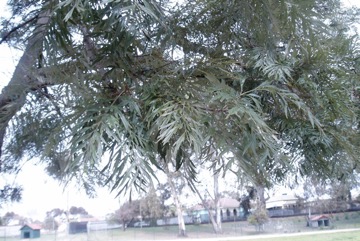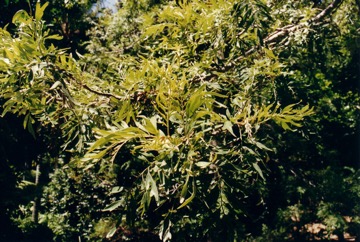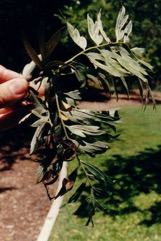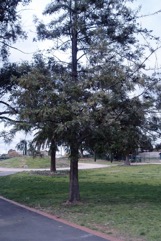Silky oak

A subtropical plant. It can grow in temperate and tropical places. It is native to E Australia. It is moderately frost hardy. It can grow in fairly dry conditions. It needs well drained soil. It can grow in full sun or light shade. In China it is cultivated as an ornamental along roadsides at low altitudes. In India it is used as a shade in coffee at elevations of 1200-2300 m altitude. It cannot tolerate lime and does best in acid soils. Once fully established in can tolerate temperatures down to 10°C. It suits hardiness zones 8-12.
Also known as:
Khar-daw-hmi, Koomkabang, Meresi, Mgrivea, Mukima, Pohon oakan sutra, Salamander, Silk-Oak Grevillea, Tuggan tuggan, Warra-garria, Yin hua
Synonyms
- Grevillea umbratica A. Cunningham
- Stylurus robusta (A.Cunn. ex R/ Br.) O. Deg.
Edible Portion
- Nectar
Where does Silky oak grow?
Found in: Africa, Argentina, Asia, Australia, Caribbean, Central Africa, Central America, China, Congo DR, Dominican Republic, East Africa, Easter Island, Eswatini, Ethiopia, Haiti, Hawaii, India, Indonesia, Jamaica, Kenya, Marquesas, Mozambique, Myanmar, Norfolk Island, North Africa, Pacific, Pakistan, Sao Tome and Principe, SE Asia, South Africa, Southern Africa, South America, Sri Lanka, St Helena, Swaziland, Tanzania, Tasmania, United States, West Indies, Zambia, Zimbabwe
Notes: There are 250 Grevillea species. It can be invasive.
Growing Silky oak
Cultivation: Plants can be grown from fresh seed. They can also be grown from cuttings and grafting.
Edible Uses: The nectar of the flowers are used to make sweet drinks. The nectar can be sucked directly from the flowers. Caution: It can cause skin rashes and the plants can contain cyanide.
Production: It is fast growing. It can take 10 years until flowering.
Nutrition Info
per 100g edible portion| Edible Part | Energy (kcal) | Protein (g) | Iron (mg) | Vitamin A (ug) | Vitamin c (mg) | Zinc (mg) | % Water |
|---|---|---|---|---|---|---|---|
| - | - | - | - | - | - |
Silky oak Photos




References
Barwick, M., 2004, Tropical and Subtropical Trees. A Worldwide Encyclopedic Guide. Thames and Hudson p 205
Bekele-Tesemma A., Birnie, A., & Tengnas, B., 1993, Useful Trees and Shrubs for Ethiopia. Regional Soil Conservation Unit. Technical Handbook No 5. p 260
Blomberry, A.M., 1979, Australian Native Plants. Angus and Robertson p 264
Bodkin, F., 1991, Encyclopedia Botanica. Cornstalk publishing, p 517
Bonney, N., 1997, Economic Native Trees and Shrubs for South Australia. Greening Australia (SA) inc. Campbelltown SA 5074 p 168
Brickell, C. (Ed.), 1999, The Royal Horticultural Society A-Z Encyclopedia of Garden Plants. Convent Garden Books. p 481
Cooper, W. and Cooper, W., 2004, Fruits of the Australian Tropical Rainforest. Nokomis Editions, Victoria, Australia. p 412
Cribb, A.B. & J.W., 1976, Wild Food in Australia, Fontana. p 182
Cronin, L., 1989, The Concise Australian Flora. Reed. p 173
Cundall, P., (ed.), 2004, Gardening Australia: flora: the gardener's bible. ABC Books. p 652
Doran, J.C., & Turnbull, J.W. (Eds), 1997, Australian Trees and Shrubs: species for land rehabilitation and farm plantings in the tropics. ACIAR Monograph No 24. p 298
Elliot, W.R., & Jones, D.L., 1990, Encyclopedia of Australian Plants suitable for cultivation. Vol 5. Lothian. p 101
Etherington, K., & Imwold, D., (Eds), 2001, Botanica's Trees & Shrubs. The illustrated A-Z of over 8500 trees and shrubs. Random House, Australia. p 357
Facciola, S., 1998, Cornucopia 2: a Source Book of Edible Plants. Kampong Publications, p 189
Flora of Australia Volume 49, Oceanic Islands 1, Australian Government Publishing Service, Canberra. (1994) p 198
Fowler, D. G., 2007, Zambian Plants: Their Vernacular Names and Uses. Kew. p 83
Greig, D., 1996, Flowering Natives for Home Gardens. Angus & Robertson. p 207
Hall, N. et al, 1972, The Use of Trees and Shrubs in the Dry Country of Australia, AGPS, Canberra. p 252
Haslam, S., 2004, Noosa's Native Plants. Noosa Integrated Catchment Assn. Inc. p 342
Hibbert, M., 2002, The Aussie Plant Finder 2002, Florilegium. p 115
Holliday, I., 1989, A Field Guide to Australian Trees. Hamlyn. p 220
Jones D, L, 1986, Ornamental Rainforest Plants in Australia, Reed Books, p 46
Krishen P., 2006, Trees of Delhi, A Field Guide. DK Books. p 250
Latham, P., 2004, Useful Plants of Bas-Congo province. Salvation Army & DFID p 142
Lazarides, M. & Hince, B., 1993, Handbook of Economic Plants of Australia, CSIRO. p 125
Llamas, K.A., 2003, Tropical Flowering Plants. Timber Press. p 321
Lord, E.E., & Willis, J.H., 1999, Shrubs and Trees for Australian gardens. Lothian. p 17
Low, T., 1991, Wild Food Plants of Australia. Australian Nature FieldGuide, Angus & Robertson. p 143
Marinelli, J. (Ed), 2004, Plant. DK. p 456
Mbuya, L.P., Msanga, H.P., Ruffo, C.K., Birnie, A & Tengnas, B., 1994, Useful Trees and Shrubs for Tanzania. Regional Soil Conservation Unit. Technical Handbook No 6. p 286
Nicholson, N & H., 1996, Australian Rainforest Plants, Terania Rainforest Publishing. NSW. p 35
Olde, P & Marriott, N., 1995, The Grevillea Book. Kangaroo Press. Vol 3. p 142
Plants of Haiti Smithsonian Institute http://botany.si.edu/antilles/West Indies
Schuler, S., (Ed.), 1977, Simon & Schuster's Guide to Trees. Simon & Schuster. No. 123
Self, M., 199, Phoenix Seeds catalogue. p 17
Staples, G.W. and Herbst, D.R., 2005, A tropical Garden Flora. Bishop Museum Press, Honolulu, Hawaii. p 468
Suppl. prodr. fl. Nov. Holl. 24. 1830
Sukarya, D. G., (Ed.) 2013, 3,500 Plant Species of the Botanic Gardens of Indonesia. LIPI p 311
Swaminathan, M.S., and Kochnar, S.L., 2007, An Atlas of major Flowering Trees in India. Macmillan. p 232
Swaziland's Flora Database http://www.sntc.org.sz/flora
Townsend, K., 1994, Across the Top. Gardening with Australian Plants in the tropics. Society for Growing Australian Plants, Townsville Branch Inc. p 239
van Wyk, B, van Wyk, P, and van Wyk B., 2000, Photographic guide to Trees of Southern Africa. Briza. p 164
Williams, J.B., Harden, G.J., and McDonald, W.J.F., 1984, Trees and shrubs in rainforests of New South Wales and Southern Queensland. Univ. of New England, Armidale. p 35
Williams, K.A.W., 1999, Native Plants of Queensland Volume 4. Keith A.W. Williams North Ipswich, Australia. p 210
World Checklist of Useful Plant Species 2020. Royal Botanic Gardens, Kew
Yallakool Reserve Plant List July 1, 2009 Off internet
Young, J., (Ed.), 2001, Botanica's Pocket Trees and Shrubs. Random House. p 419
Zizka, G., 1991, Flowering Plants of Easter Island. Palmarum Hortus Francofurtensis